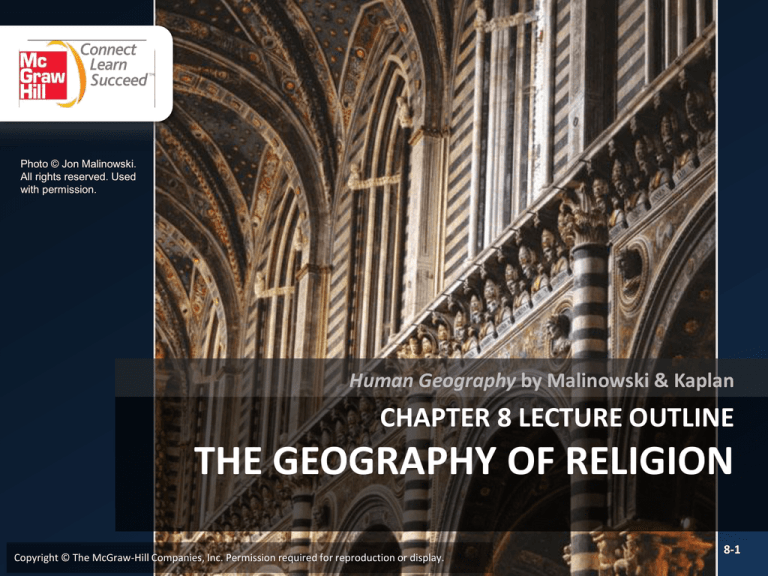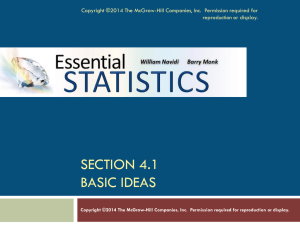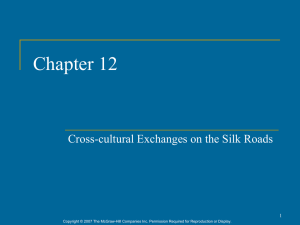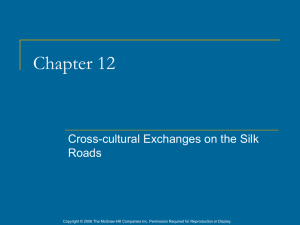
Photo © Jon Malinowski.
All rights reserved. Used
with permission.
Human Geography by Malinowski & Kaplan
CHAPTER 8 LECTURE OUTLINE
THE GEOGRAPHY OF RELIGION
Copyright © The McGraw-Hill Companies, Inc. Permission required for reproduction or display.
8-1
Chapter 8 Modules
•
•
•
•
•
•
•
•
•
•
8A Classifying Religions
8B Major World Religions
8C Hinduism
8D Buddhism
8E Judaism
8F Christianity
8G The Spread and Distribution of Christianity
8H Islam
8I Other Large Religious Groups
8J Landscapes of Religion
Copyright © The McGraw-Hill Companies, Inc. Permission required for reproduction or display.
8-2
8A: Classifying Religions
• Religion
• A cultural system of beliefs, traditions, and practices
often centered around the worship of a deity or
deities
• Universalizing religions
• Religions that seek to convert nonbelievers
• Examples: Christianity, Islam
• Ethnic religions
• A religion closely associated with a particular ethnic
group
• Examples: Judaism, Hinduism
Copyright © The McGraw-Hill Companies, Inc. Permission required for reproduction or display.
8-3
World Religions
Copyright © The McGraw-Hill Companies, Inc. Permission required for reproduction or display.
Figure 8B.1
8-4
8C: Hinduism
• At least 4,000-5,000
years old
– Geographically
concentrated in
India and British
colonial areas
– 1 million Hindus in
the United States
Copyright © The McGraw-Hill Companies, Inc. Permission required for reproduction or display.
8-5
8C: Hindu Beliefs
• Dharma
– One’s duties or obligations in life
– Basis of the caste system
• Karma
– Every action has consequences
– Can affect your next life
• Reincarnation
– A person’s soul goes through cycles of death and rebirth
– When an organism dies, the soul passes to another life
form
– The cycle can be broken (moksha)
Copyright © The McGraw-Hill Companies, Inc. Permission required for reproduction or display.
8-6
8C: Hindu Worship
• Polytheistic
– Millions of gods and
goddesses
– Vishnu & Shiva have
large sects
• The Vedas
– Holy books
• Worship is more
individual than
communal
Ganesh
Copyright © The McGraw-Hill Companies, Inc. Permission required for reproduction or display.
8-7
8D: Buddhism 1
• Based on the teachings of
Siddhartha in the 5th-6th
century BCE
• Buddhists believe that all
living things are reborn, but
the cycle can be broken
• Four Noble Truths
– Life is suffering
– Suffering is caused by desire
and craving
– Suffering can be ended
– Desire can be eliminated
through the Eightfold Path
Copyright © The McGraw-Hill Companies, Inc. Permission required for reproduction or display.
8-8
8D: Buddhism 2
• After Buddha’s death, his
teachings were passed down
and eventually written down
in the Pali Canon
• Over time, Buddhism spread
into 3 main forms
• Theravada
– Southeast Asia
• Mahayana
– China, East Asia, Southeast
Asia
• Vajrayana
– Tibet & Mongolia
Copyright © The McGraw-Hill Companies, Inc. Permission required for reproduction or display.
8-9
8E: Judaism 1
• Small but influential faith
• Ethnic religion
• Believe themselves to be the chosen people of God
• Expelled from what is now Israel by the Romans
– The Diaspora
– Jewish populations settled throughout the Middle East,
North Africa, and southern Europe
Copyright © The McGraw-Hill Companies, Inc. Permission required for reproduction or display.
8-10
The Diaspora
Copyright © The McGraw-Hill Companies, Inc. Permission required for reproduction or display.
Figure 8E.1
8-11
8E: Judaism 2
• Worship in synagogues or temples
• Believe God gave humans his law through
the Torah
• Sabbath is Friday night and Saturday
• Numerous annual holidays
• Observant Jews are required to keep a
kosher diet
Copyright © The McGraw-Hill Companies, Inc. Permission required for reproduction or display.
8-12
8F: Christianity 1
• Over 2 billion adherents
• Rooted in the Jewish
tradition
• Believe that Jesus is the
Messiah
– Christ is Greek for
anointed one
• Wide variety in ways
that Christians worship
• Sabbath is Sunday
Copyright © The McGraw-Hill Companies, Inc. Permission required for reproduction or display.
8-13
The Spread of Christianity in
Europe
Copyright © The McGraw-Hill Companies, Inc. Permission required for reproduction or display.
Figure 8G.1
8-14
8H: Islam 1
• Younger than the other major world religion
• Origins in the 6th-7th century C.E. and the Prophet
Muhammad
• The Islamic calendar begins with the Hijra in 622
C.E.
• Primary source of Muslim belief is the Qur'an,
which Muslims believe contain the actual words of
God revealed to Muhammad
• Disagreements over succession after Muhammad’s
death led to the split between Sunnis and Shi’ites
Copyright © The McGraw-Hill Companies, Inc. Permission required for reproduction or display.
8-15
Diffusion of Islam
Copyright © The McGraw-Hill Companies, Inc. Permission required for reproduction or display.
Figure 8H.3
8-16
8H: Islam 2
• Five Pillars of Islam
1. A confession of faith, known as the Shahadah. It is, simply,
“There is no god but God, and Muhammad is His Prophet.”
2. Prayer. Muslims are expected to pray five times a day.
During prayer, Muslims face in the direction of Mecca, no
matter where they are in the world.
3. Charity. Muslims, except the poor, are expected to give onefortieth of their income and possessions to the poor each
year.
4. Observance of the holy month of Ramadan. During
Ramadan, Muslims fast during the day and only take food or
drink in moderation at night.
5. Pilgrimage, or the Hajj. Every able-bodied Muslim who can
afford the journey is expected to make a pilgrimage to
Mecca once during his or her lifetime.
Copyright © The McGraw-Hill Companies, Inc. Permission required for reproduction or display.
8-17
8I: Other Large Religious Groups 1
• Chinese folk religions
– Confucianism
• Began in the 5th-6th centuries B.C.E.
• Emphasizes proper relationships in society
– Taoism
• Mystical and esoteric
• Focused on morality, self-restraint, & humility
• African Traditional Religion
– A catch-all term for dozens of traditions
– Animistic
– Emphasis is on maintaining order in society
Copyright © The McGraw-Hill Companies, Inc. Permission required for reproduction or display.
8-18
8I: Other Large Religious Groups 2
• Sikhism
– Founded by Guru Nanak in the 15th century in
what is now Punjab in India/Pakistan
– Rejected key ideas of Hinduism and Islam, the
key religions in the area
– About 20 millions adherents worldwide
• Jainism
– Developed as a reaction to Hinduism in the 6th
century B.C.E.
– Goal is to eliminate sources of bad karma
Copyright © The McGraw-Hill Companies, Inc. Permission required for reproduction or display.
8-19
8I: Other Large Religious Groups 3
• Baha'i
– Founded in the 19th century in what is now Iran &
Iraq
– Universalizing. Seeks to unite all the peoples of the
world
– About 6 millions adherents
• Shinto
– Ancient, ethnic, religion of Japan
– Animistic
– Most Japanese will engage in both Shinto and
Buddhist religious activities
Copyright © The McGraw-Hill Companies, Inc. Permission required for reproduction or display.
8-20
8J: Landscapes of Religion 1
• Unique buildings
– Churches, mosques, temples, etc.
• Some cities are organized around religious
buildings
• Religions also have internal geographies, like
dioceses in the Catholic Church
• Cemeteries, religious schools, monuments, etc.
• Pilgrimage sites
• Sacred vs. profane landscapes
Copyright © The McGraw-Hill Companies, Inc. Permission required for reproduction or display.
8-21
8J: Landscapes of Religion 2
• Types of Sacred Places (after Jackson & Henrie):
– Historical sites
• Western Wall (Judaism)
• Karbala, Iraq (Shi’ite Muslims)
– Homelands
• Chaco Canyon, New Mexico was home to Puebloan Indians
– Mystico-Religious Sites
• Places where the religion feels that a deity came into
contact with humans
– Dome of the Rock (Muslims)
– Bodhi Tree (Buddhists)
Copyright © The McGraw-Hill Companies, Inc. Permission required for reproduction or display.
8-22












